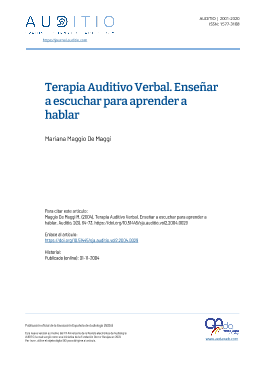Terapia Auditivo Verbal. Enseñar a escuchar para aprender a hablar
DOI:
https://doi.org/10.51445/sja.auditio.vol2.2004.0029Palabras clave:
terapia auditivo verbal, evaluacion audiologica, adaptacion protesica infantil, intervención centrada en la familiaResumen
La Terapia Auditivo Verbal es un enfoque terapéutico para la educación de los niños sordos donde se enfatiza el desarrollo de las habilidades auditivas para la adquisición del lenguaje a través de la audición. Para ello, los niños deben ser identificados, diagnosticados y equipados con la amplificación óptima lo más tempranamente posible. Se les enseña a los padres a crear un ambiente en donde su hijo aprenda a escuchar, a procesar el lenguaje verbal y a hablar. En el presente artículo se hace una breve reseña histórica del desarrollo de esta metodología y se describen en forma extensiva sus principios fundamentales relacionados con la evaluación audiológica, la adaptación protésica, el uso funcional de la audición y la intervención centrada en la familia.
Descargas
Visibility and Altmetrics
Métricas
Estadísticas globales ℹ️
|
7293
Visualizaciones
|
36031
Descargas
|
|
43324
Total
|
|
Citas
The Auditory Verbal International Mission Statement.( 2001) The Auricle 13, 2. https://doi.org/10.1097/00006247-200108000-00004
Flexer, C. (1997). The Power of Hearing - audiological foundations for the development of spoken language. Paper presented at "A Sound Celebration".. Voice and Auditory Verbal International, Inc. 's 10th Anniversary Conference, Canada.
Yoshinaga-Itano C, Apuzzo ML. (1989). Identification of hearing loss after age 18 months is not early enough. Am Ann Deaf 1998 Dec;143(5):380-7. https://doi.org/10.1353/aad.2012.0151
Yoshinaga-Itano C, Sedey AL, Coulter DK, Mehl AL. (1998). Language of early- and lateridentified children with hearing loss. Pediatrics;102 (5):1161-71. https://doi.org/10.1542/peds.102.5.1161
Downs MP, Yoshinaga-Itano C. (1999). The efficacy of early identification and intervention for children with hearing impairment .Pediatr Clin North Am Feb;46(1):79-87. https://doi.org/10.1016/S0031-3955(05)70082-1
Moeller MP. (2000). Early intervention and language development in children who are deaf and hard of hearing. Pediatrics 2000 Sep;106(3):E43. https://doi.org/10.1542/peds.106.3.e43
Pollack, D. (1970). Educational Audiology for the Limited- Hearing Infant. Springfield, IL : Charles C. Thomas.
Ling, D. (1989). Foundations of Spoken Language for Hearing Impaired Children. Washington, DC:AGB. https://doi.org/10.1097/00003446-199008000-00013
Auditory -Verbal International. Scope of Practice. Easton PA. 1993.
Gravel, J. (2002). Potencial pitfalls in the audiological assessment of infants and young children. En A sound foundation through early amplification 2001. Ed. Seewald R. & Gravel, J. Phonak AG.
Boothroyd, A. (1997). Auditory Development of the hearing child. Scandinavian Audiology, 26 (S uppl.46) 9-16.
Feigin, J.A.,Kopun, J.G., Stelmachowicz, P.G. & Gorga, M.P. (1989) Probetube microphone measures of ear-canal sound pressure levels in infants and children. Ear and Hearing, 10. https://doi.org/10.1097/00003446-198908000-00008
Auditory- Verbal International. Suggested Protocol for Audiological and Hearing Aid Evaluation. The Auricle , Summer 1993.
Estabrooks, W. (1998). Cochlear Implants for kids. Washington, DC: A.G. Bell.
Talbot, P. (2003). Temas de Terapia Auditivo Verbal: Una Selección de Apuntes. Trad. Mariana Maggio De Maggi. Auditory Verbal International.
Oliver, J. (2001) en 50FAQ About AVT. Ed. Estabrooks, W. AVI.
Seewald, R.C. (1995). The Desired Sensation Level (DSL) method for hearing aid fitting in infants and childrens. Phonak Focus 20. Stäfa, Switzerland :Phonak AG.
Stelmachowicz, P.G., Kalberer, A., & Lewis, D.E. (1996). Situational Hearing Aid Response Profile (SHARP). En F.H. Bess, J.S. Gravel, & A.M. Tharpe (Eds.), Amplification for children with auditory deficits.Nashville, TN: Bill Wilkerson Center Press.
Hawkins, D.B. (1984). Comparisons of speech recognition in noise by mildly-to-moderately hearingimpaired children using hearing aids and FM systems. Journal of Speech and Hearing Disorders, 49. 1984. https://doi.org/10.1044/jshd.4904.409
Launer, S. & Kühnel , V. (2002). Signal processing for sever-to-profound hearing loss. En A sound foundation through early amplification 2001. Ed. Seewald R. & Gravel, J. Phonak AG.
Marlowe, J. (2002). Learning to listen from paradox to paradigm through early amplification. The Auricle. Vol 13 No. 1.
Hoover, B. (2001) Hearing Aid fitting in infants. The Volta Review, Volume 102 (2), 57-73. 2001.
Auditory -Verbal International . Auditory- Verbal Position Statement. The Auricle 4 (4) , 11- 15. 1991. 24. Rhoades, E. (2001). Language progress with an Uditory-Verbal approach for young children with hearing loss. International Pediatrics/Vol 16/No.1/2001.
Dornan, D. (1999).Let's Hear and Say: A current Overview of Auditoy-Verbal Therapy. The Auricle Fall/Winter. https://doi.org/10.1179/136132899805577079
Conclusiones del Primer Congreso Europeo de Familias de Deficientes Auditivos. En revista FIAPAS No.87/Julio-Agosto 2002.

Publicado
Versiones
- 2021-09-15 (2)
- 2004-11-01 (1)
Cómo citar
Número
Sección
Licencia
Derechos de autor 2004 Auditio

Esta obra está bajo una licencia Creative Commons Reconocimiento 3.0 Unported.
Todos los artículos serán publicados bajo la licencia abierta Creative Commons Attribution (CC-BY). Esta licencia permite a otros compartir y adaptar el contenido, incluso con fines comerciales, siempre que se dé el reconocimiento adecuado a los autores y a la revista. Al enviar su manuscrito, los autores retienen los derechos de autor pero otorgan a la revista el derecho a realizar la primera publicación bajo esta licencia.
Más información sobre esta licencia disponible en: https://creativecommons.org/licenses/by/4.0/
Publicaciones 2001-2020
Los textos publicados en esta revista en la seccion de "AUDITIO 2001-2020 están sujetos –si no se indica lo contrario– a una licencia de Reconocimiento 3.0 España de Creative Commons. Puede copiarlos, distribuirlos, comunicarlos públicamente, hacer obras derivadas y usos comerciales siempre que reconozca los créditos de las obras (autoría, nombre de la revista, institución editora) de la manera especificada por los autores o por la revista. La licencia completa se puede consultar en http://creativecommons.org/licenses/by/3.0/es/deed.es.








 AUDITIO | Spanish Journal of Audiology
AUDITIO | Spanish Journal of Audiology
